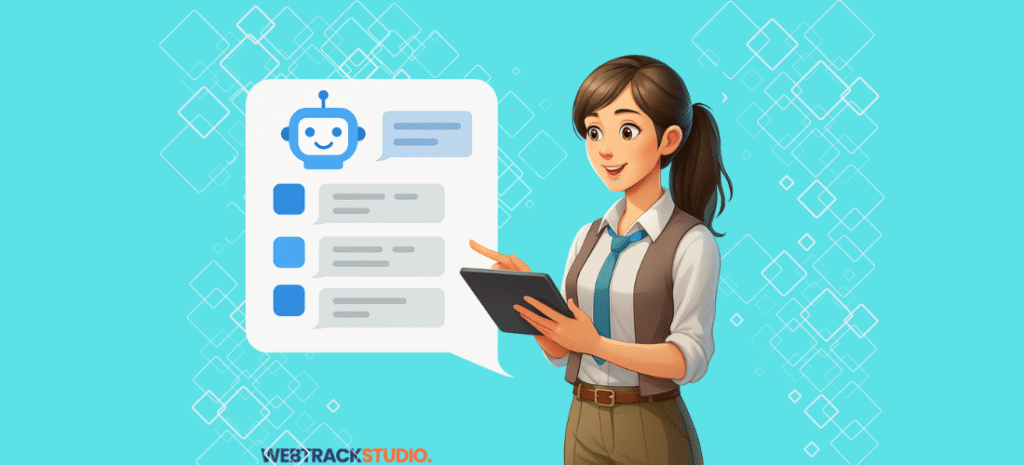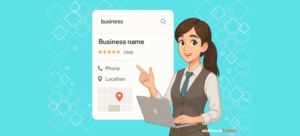Table of Contents
- Key Benefits for Business
- How AI Chatbots work with live support
- Implementation Guide
- Free Tools by Business Type
- Common Mistakes to Avoid
- Tracking Your Results
- Frequently Asked Questions
- Conclusion
Modern customers expect immediate responses. Studies show that 82% of consumers want instant answers to their questions. Meeting this demand without increasing costs requires a strategic approach: combining AI chatbots with human live support.
AI chatbots handle routine questions automatically. Live support provides human expertise for complex issues. Together, they create an efficient customer service system that operates 24/7 while reducing operational costs.
This guide explains how to implement this system in your business. You will learn which tools to use, how to set them up, and how to avoid common problems.

Key Benefits for Business
Lead Generation and Qualification
AI chatbots engage website visitors within seconds. They ask qualifying questions about budget, needs, and timeline. This process happens continuously, even outside business hours.
Your sales team receives pre-filtered, high-quality leads. Businesses using chatbots for lead capture report 30-50% higher conversion rates compared to traditional web forms. The conversational interface feels natural and provides immediate engagement.
Reduced Customer Acquisition Costs
Chatbots handle 60-80% of routine inquiries without human intervention. Your support team focuses on complex, high-value interactions. This efficiency directly reduces the cost per acquired customer.
Consider the operational savings, A chatbot can manage hundreds of simultaneous conversations. A human agent typically handles one conversation at a time. This scalability becomes increasingly valuable as your business grows.
Improved Customer Retention
Fast, accurate support increases customer satisfaction. When customers resolve simple issues instantly through chatbots and escalate complex problems to knowledgeable humans, they remain loyal longer.
Repeat customers spend 67% more than new customers. This makes retention-focused support a significant revenue multiplier. The combination of speed (from chatbots) and expertise (from humans) creates an optimal support experience.
Operational Efficiency
Live support alone requires significant staffing to maintain coverage. AI chatbots provide constant availability without additional salary costs. This allows businesses to maintain service quality during peak periods without temporary staff.
The system scales efficiently. Adding capacity for 1,000 more monthly conversations with chatbots costs minimal additional fees. Adding capacity with human agents requires hiring, training, and managing additional staff.
How AI Chatbots work with live support
AI chatbots excel at specific tasks:
- Information Delivery: Providing product specifications, pricing, and availability without delay. Customers receive accurate information instantly, improving their decision-making process.
- Simple Transactions: Handling order tracking, appointment scheduling, and form submissions through automated workflows.
- Initial Assessment: Gathering customer information and understanding the nature of their inquiry before routing to appropriate resources.
- 24/7 Availability: Responding to inquiries during nights, weekends, and holidays when human agents are unavailable.
Live support handles different responsibilities:
- Complex Problem-Solving: Addressing technical issues that require expertise and multi-step troubleshooting.
- Sensitive Situations: Managing complaints, billing disputes, and emotional interactions that require empathy.
- Strategic Decisions: Handling special requests, custom orders, and situations requiring judgment beyond predefined rules.
- Building Relationships: Creating personal connections with high-value customers through genuine human interaction.
The Handoff Process (Final Steps)
The transition from chatbot to human agent is critical. When executed properly, customers experience seamless service. Poor execution frustrates customers and damages satisfaction scores.
Trigger Conditions: The system automatically escalates conversations when:
- The customer requests human assistance directly
- The chatbot fails to understand the inquiry after two attempts
- Negative sentiment is detected through language analysis
- Specific high-priority keywords appear (refund, complaint, urgent, broken)
- The customer is identified as high-value through CRM integration
Context Transfer: When escalation occurs, the human agent receives the complete conversation history. This includes all information the customer provided and all responses the chatbot delivered. Agents can immediately continue the conversation without requiring customers to repeat information.
Customer Communication: The system notifies customers when transferring them to a human agent. This manages expectations and explains the slight wait time for agent availability.
Implementation Guide
Step 1: Analyze Your Current Support (Week 1)
Review your existing customer interactions. Examine support tickets, chat logs, and email inquiries from the past three months. Create two lists:
Suitable for Chatbots:
- Frequently asked questions about products, services, or policies
- Order status and tracking requests
- Business hours and location information
- Account access issues like password resets
- Appointment scheduling and rescheduling
- General product information requests
Requires Human Support:
- Technical troubleshooting beyond basic steps
- Billing disputes or payment problems
- Customer complaints requiring resolution
- Custom requests or special accommodations
- Situations involving frustration or dissatisfaction
This analysis creates your implementation blueprint. Focus your chatbot development on the high-frequency, simple inquiries that currently consume agent time.
Step 2: Select Your Platform (Week 1-2)
Choose tools that integrate with your existing systems. Your chatbot platform must connect to your website, CRM, and communication channels without extensive custom development.
Selection Criteria:
- Compatibility with your website platform (WordPress, Shopify, custom site)
- Integration capability with your existing CRM and support tools
- Ease of setup without requiring programming knowledge
- Scalability to grow with your business needs
- Mobile responsiveness for smartphone users
Most modern platforms offer free trials. Test 2-3 options with your specific use cases before committing.
Step 3: Build Your Knowledge Base (Week 2)
Create comprehensive content for your chatbot to reference:
Documentation Required:
- Answers to all frequently asked questions
- Complete product or service information
- Policies (return, refund, privacy, terms of service)
- Troubleshooting guides for common issues
- Contact information and business hours
Organize this information clearly. Use simple language and short sentences. AI chatbots learn from this content to answer variations of questions, not just exact matches.
Step 4: Configure Conversation Flows (Week 2-3)
Design how the chatbot guides customers through common scenarios:
Basic Flow Structure:
- Greeting and identification of customer need
- Information gathering through targeted questions
- Solution delivery or escalation to human agent
- Confirmation that the issue is resolved
Map each common inquiry type separately. For example, a refund inquiry flow differs significantly from a technical support flow.
Example Flow – Order Tracking:
- Bot: “I can help you track your order. Please provide your order number.”
- Customer: [Provides number]
- Bot: [Retrieves status] “Your order #12345 shipped on October 8 and will arrive by October 12. Would you like tracking details?”
- Customer: “Yes”
- Bot: [Provides tracking link] “Is there anything else I can help with?”
Step 5: Set Escalation Rules (Week 3)
Program specific conditions for transferring conversations to human agents:
Automatic Escalation Triggers:
- Direct customer request (“I need to speak with someone”)
- Chatbot confidence score below threshold (uncertainty about correct response)
- Negative sentiment detected in customer language
- Specific keywords indicating urgency or complexity
- Customer identified as VIP or high-value account
Escalation Configuration:
- Define which team receives each escalation type (billing vs. technical vs. sales)
- Set agent availability schedules
- Create backup plans for after-hours escalations
- Configure context transfer to include full conversation history
Step 6: Train Your Team (Week 3-4)
Prepare human agents for the new workflow:
Technical Training:
- How to access and read chatbot conversation transcripts
- How to pick up conversations smoothly without repetition
- How to use information already gathered by the chatbot
Strategy Training:
- Understanding that chatbots handle volume, humans handle complexity
- Recognizing when to override chatbot information if incorrect
- Identifying patterns in escalations that indicate chatbot training needs
Conduct role-playing exercises where team members practice receiving escalated conversations and using the provided context effectively.
Step 7: Launch and Monitor (Week 4+)
Begin with limited deployment to test system performance:
Soft Launch Approach:
- Activate chatbot for 20-30% of website traffic initially
- Monitor all conversations closely for problems
- Collect feedback from both customers and agents
- Identify and fix issues before full deployment
Key Metrics to Track:
- Chatbot containment rate (conversations resolved without escalation)
- Average response time for both chatbot and human responses
- Customer satisfaction scores from post-interaction surveys
- Escalation patterns showing which topics need improvement
Use this data to refine chatbot responses and adjust escalation rules weekly.
Free Tools by Business Type
E-commerce and Online Retail
Tidio Free Plan
Tidio provides AI chatbots and live support in one platform specifically designed for online stores.
Features:
- Handles up to 100 unique visitors per month
- Includes basic chatbot templates for order tracking and product questions
- Integrates directly with Shopify, WooCommerce, and WordPress
- Mobile apps for agents to respond on the go
Setup Process:
- Create a free account at tidio.com
- Select your e-commerce platform from the integration options
- Install the plugin or paste the provided code into your website
- Choose a pre-built template for order tracking and product inquiries
- Customize responses with your specific product information and policies
- Set your business hours for when human agents are available
- Test the chatbot by placing a test order and tracking it through the system
Best Use: Small to medium online stores needing basic automation for order questions and product information.
Service-Based Businesses
Tawk.to Complete Free Plan
Tawk.to offers unlimited agents and conversations with no visitor restrictions, making it ideal for service businesses with fluctuating inquiry volumes.
Features:
- Unlimited messaging capacity
- No monthly visitor limits
- Live chat and basic chatbot functionality
- Mobile applications for iOS and Android
- Real-time visitor monitoring
Setup Process:
- Register for a free account at tawk.to
- Create a property for your website
- Copy the provided JavaScript code
- Paste the code before the closing </body> tag on your website
- Configure chatbot using the visual flow builder
- Create conversation paths for appointment scheduling and service inquiries
- Set agent availability and routing rules
- Test all conversation flows with various inquiry types
Best Use: Consulting firms, legal services, healthcare providers, and professional services requiring appointment scheduling.
Software and Technology Companies
HubSpot Free CRM with Chatbot
HubSpot provides integrated chatbots, live support, and customer relationship management in their free tier.
Features:
- AI chatbots with qualification logic
- Live chat included
- Contact and deal tracking in CRM
- Email integration and tracking
- Forms and landing page tools
Setup Process:
- Create a free HubSpot account
- Install the HubSpot tracking code on your website
- Navigate to Conversations > Chatflows in the dashboard
- Build a qualification bot asking about company size, role, and specific needs
- Connect the chatbot to forms that create new contacts in your CRM
- Set up routing rules to direct qualified leads to your sales team
- Configure notifications for new conversations and qualified leads
- Test the qualification flow with different scenarios
Best Use: SaaS companies, software developers, and technology businesses needing lead qualification and CRM integration.
Local Service Businesses
Facebook Messenger for Business
Facebook Messenger integrates with your business page and reaches customers on the platform they already use daily.
Features:
- Completely free through your Facebook business page
- Automated greeting and away messages
- Quick replies for common questions
- Integration with Instagram Direct Messages
Setup Process:
- Ensure your business has a Facebook business page
- Enable messaging in page settings
- Configure instant replies with your business hours and basic information
- Create saved replies for frequently asked questions
- Set up away messages for after-hours inquiries
- Download the Facebook Pages Manager app for mobile access
- For advanced automation, connect ManyChat free plan (up to 1,000 contacts)
- Build automated flows for appointment booking and common questions
Best Use: Restaurants, salons, fitness centers, and local services where customers primarily use social media.
Understanding Free Plan Limitations
Free tools provide substantial functionality but include certain restrictions:
Common Limitations:
- Maximum monthly conversation or visitor counts
- Branding on chat widgets (showing the tool provider’s logo)
- Basic chatbot logic without advanced AI learning
- Limited integrations with third-party tools
- Standard analytics without custom reporting
For businesses exceeding 1,000 monthly conversations or requiring advanced features, budget $50-300 monthly for professional plans.
Common Mistakes to Avoid
Mistake 1: Hiding Human Support Options
Some businesses make it difficult to reach a human agent, hoping chatbots will handle everything. This frustrates customers and damages trust.
The Problem: Customers feel trapped when they cannot find a way to speak with a person. This creates negative experiences even if the chatbot eventually solves their problem.
The Solution: Always provide clear, prominent access to human support. Add a persistent “Speak with an agent” button visible at all times during chatbot conversations. Never require customers to complete a sequence of chatbot questions before allowing escalation.
Mistake 2: Losing Conversation Context
When customers must repeat their problem to human agents after speaking with a chatbot, satisfaction drops significantly.
The Problem: Poor integration between chatbot and live support systems causes information loss during handoffs. Agents see a new conversation without context about what the customer already discussed.
The Solution: Verify during implementation that agents automatically receive full chatbot conversation transcripts. Configure your system to display this context prominently in the agent dashboard. Train agents to reference this information when greeting customers.
Mistake 3: Overestimating Chatbot Capabilities
Businesses sometimes claim chatbots can handle complex scenarios they cannot, leading to disappointed customers.
The Problem: Customers expect comprehensive solutions based on initial chatbot promises. When the bot cannot deliver, trust erodes and escalation becomes more difficult.
The Solution: Be transparent about chatbot limitations. Use greetings that clearly state what the chatbot can and cannot handle. Set realistic expectations from the first interaction.
Mistake 4: Neglecting Agent Training
Human agents unaccustomed to working with chatbots may struggle with the new workflow.
The Problem: Agents might not understand how to interpret chatbot transcripts effectively. They may duplicate questions the chatbot already asked or feel uncertain about their role in the new system.
The Solution: Provide comprehensive training on the integration’s purpose and mechanics. Explain how chatbots remove repetitive work, allowing agents to focus on complex, interesting problems. Create clear protocols for smooth takeovers.
Mistake 5: Using Outdated Chatbot Content
Customer questions evolve, products change, and policies update. Chatbots with outdated information create more problems than they solve.
The Problem: Customers receive incorrect information from chatbots, requiring escalation to correct the misinformation. This wastes time and damages credibility.
The Solution: Schedule monthly reviews of chatbot performance. Update responses when products, services, or policies change. Analyze frequently escalated topics to identify knowledge gaps requiring new content.
Mistake 6: Ignoring Mobile Users
Over 60% of website traffic originates from mobile devices, yet many chatbot implementations prioritize desktop experience.
The Problem: Chatbot interfaces that cover critical screen space or include tiny, difficult-to-tap buttons frustrate mobile users. This leads to abandonment and negative experiences.
The Solution: Test chatbot interfaces extensively on various smartphones and tablets. Ensure text remains readable, buttons are appropriately sized for touch interaction, and the widget can be minimized without losing conversation progress.
Mistake 7: Launching Without Success Metrics
Implementing chatbots and live support without defining success measures makes optimization impossible.
The Problem: Without baseline metrics and goals, businesses cannot determine if the implementation improves performance or justify the investment.
The Solution: Establish baseline measurements before launch. Track average response time, customer satisfaction scores, and support costs per interaction. Set specific improvement targets and review progress quarterly.
Tracking Your Results
Monitor these essential metrics after implementation:
Chatbot Containment Rate: Target 60-70% of conversations resolved without human escalation. This shows your chatbot handles routine tasks effectively.
Customer Satisfaction Score: Use post-chat surveys to measure satisfaction. Aim for scores matching or exceeding your current baseline.
Response Time: Track how quickly customers receive answers. AI chatbots typically respond in under 5 seconds, while human agents average 2-3 minutes.
Monthly Cost Per Conversation: Calculate total support costs divided by conversations handled. This should decrease as chatbots handle more volume.
Frequently Asked Questions
No, and complete replacement is not the goal. AI chatbots excel at handling repetitive, information-based tasks with consistency and speed. However, they lack human judgment, emotional intelligence, and creative problem-solving abilities.
The optimal approach combines chatbot efficiency for routine tasks with human expertise for complex situations. Successful implementations reduce human workload by 60-70% while maintaining or improving overall service quality through this collaborative model.
Small businesses using free or low-cost tools typically need 2-4 weeks from planning to launch. This timeframe includes defining support structure, configuring systems, creating conversation flows, testing functionality, and training staff.
Larger enterprises with custom requirements may need 2-3 months. The key to success is starting simple with core functionality and adding complexity gradually rather than attempting to build a perfect system immediately.
Well-designed systems handle this situation through graceful escalation. The chatbot should acknowledge its limitation (“Let me connect you with someone who can help with that specific question”), capture all conversation context, and immediately route the conversation to an available human agent.
Avoid chatbots that loop endlessly attempting to understand or that reach dead ends without offering human access options.
Preference depends entirely on context and situation. For simple, quick questions about hours, locations, or order status, most customers prefer instant chatbot responses over waiting for available human agents.
For complex problems, emotionally sensitive situations, or issues requiring judgment, customers strongly prefer human interaction. Successful implementations give customers choice—allowing self-service for simple needs and easy escalation when human interaction is desired.
Free tools work effectively for businesses handling under 1,000 monthly conversations. Small businesses managing 1,000-5,000 conversations should budget $50-150 monthly. Medium businesses handling 5,000-20,000 conversations typically spend $150-500 monthly.
Enterprises or businesses requiring advanced features like sophisticated AI training, complex routing logic, or extensive integrations should budget $500 or more monthly.
Only if implemented poorly. Chatbots with appropriate personality, clear limitations, and easy human access enhance rather than diminish customer experience.
The key is transparency. Inform customers they are interacting with automation, explain what it can help with, and make human support obviously accessible. Many customers appreciate efficient automation for routine tasks, reserving human interaction for situations where it provides genuine value.
Monitor these key indicators regularly:
- Containment Rate: 60-70% of conversations should resolve without human escalation. Lower rates suggest over-reliance on escalation. Higher rates may indicate customers cannot access human help when needed.
- Customer Satisfaction: Post-interaction surveys should show satisfaction scores for chatbot interactions matching or exceeding your baseline performance.
- Resolution Time: Average time to resolve issues should decrease as chatbots handle routine queries instantly.
- Escalation Patterns: Analyze which topics consistently require human intervention. These patterns reveal knowledge gaps requiring additional chatbot training.
Yes, and this approach often proves highly effective. Platforms like Facebook Messenger, Instagram, and WhatsApp support chatbot integrations. Many customers prefer messaging businesses through social media rather than visiting websites.
Tools like ManyChat and Chatfuel specialize in social media chatbot deployment. The same implementation principles apply—use automation for routine interactions and escalate to humans for complex situations.
Conclusion
Start by analyzing your current support inquiries. Identify the 10-15 most common simple questions. These become your chatbot’s initial responsibilities.
Select one recommended free tool based on your business category. Spend several hours creating a basic version focused exclusively on those common questions. Resist the temptation to build a comprehensive system immediately.
Test thoroughly with your team before launching to customers. Have everyone attempt to break the system and identify gaps. Refine based on this internal feedback.
Launch to a small percentage of your traffic initially. Monitor closely during the first week. Watch for confusion, escalation patterns, and customer reactions. Adjust quickly based on real-world usage.
Commit to ongoing improvement. Schedule monthly reviews analyzing performance data, updating chatbot knowledge, and refining escalation rules. Businesses achieving the highest ROI from AI chatbots and live support integration treat it as an evolving system requiring continuous optimization.
Need assistance implementing AI chatbots and live support for your business? Contact us or email us at in**@************io.com for guidance on selecting and configuring the appropriate tools for your specific requirements.


